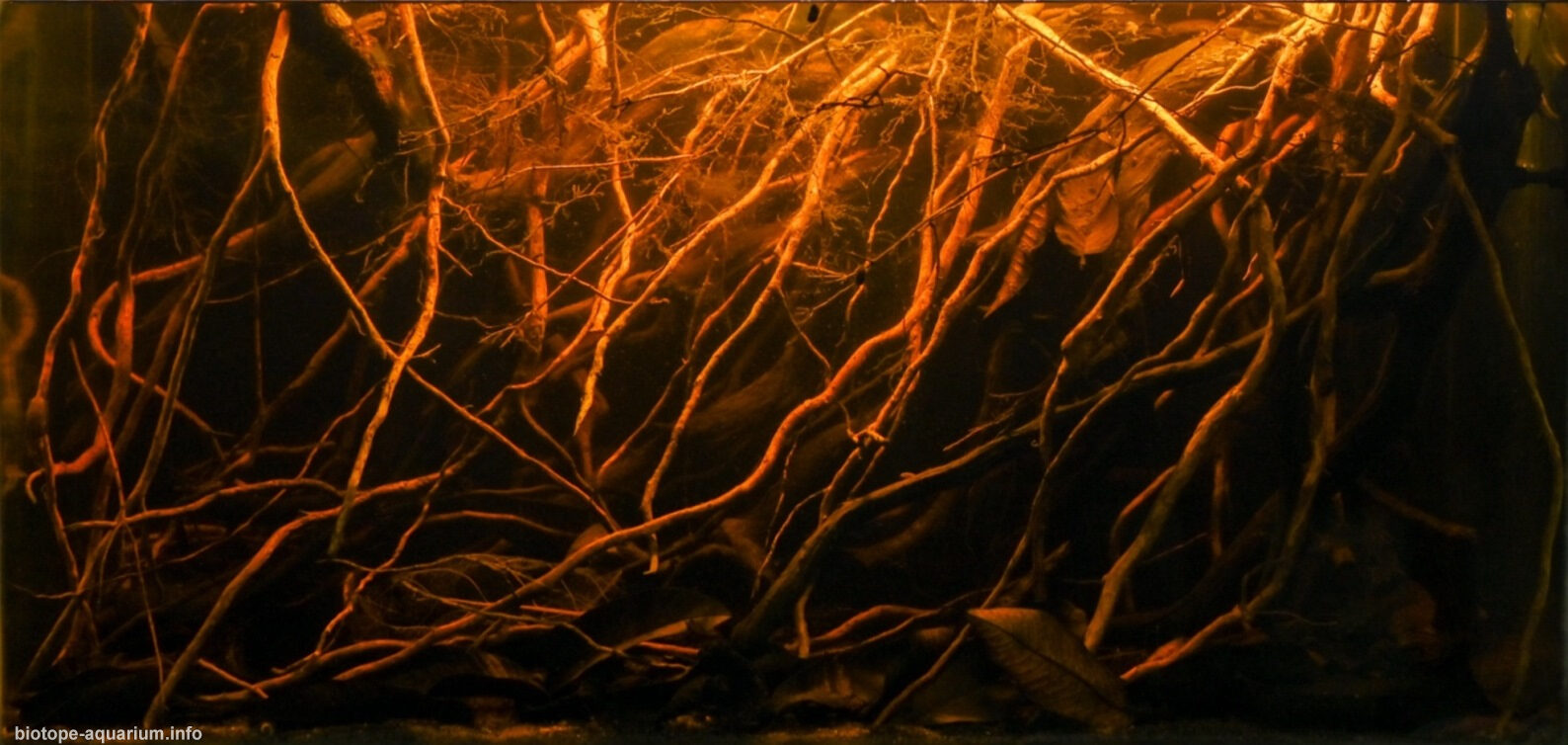Small forest creek in Rio Negro system, Amazonas, Brazil
_st place in Biotope Aquarium Design Contest 2022

Volume of aquarium: 115
Dimensions of aquarium: 76.2×38.1×38.1
List of fishes: Paracheirodon axelrodi, Hemigrammus rhodostomus
List of plants: NA
Description of Decorations and Substrate: The basis of the decorations is the roots of the vine, resembling flooded trees inherent in the area. The stone heaps are made of rock, which in form, texture and color are similar to boulders from a natural reservoir. The substrate of yellowish sand is identical in color and fraction to the sand of that area. The leaves of the alder cover the bottom of the aquarium, making a similar in appearance foliate litter characteristic for this biotope. Monstera deliciosa is widespread in this part of the continent, the roots of which are located right inside the aquarium, imitating plants that have fallen into the water after a flood during the rain season
Description of Equipment: Filteration: EHEIM eXperience 150
Heater: EHEIM thermopreset 100
Lightning: 1pics fireglow 6500k & 21W , 6W Spot
Water Parameters: The temperature is 26°C; KH is 7; GH is 9; PH is 5.8 – 6.2
Additional Info:
Aquarium video:
Description of the Area Surrounding the Biotope: Black water of South America is primarily a landscape of sand covered with tangles of roots, leaves, algae and fish perfectly adapted to this difficult environment. The water is tea-colored, barren and very sour. They are part of the great Amazonian basin water system.
The forest surrounding this small river reflects many organic substances. These are primarily leaves and fruits falling from trees and rinsed during the rainy season, as well as roots and broken branches. They rot and give off tannins and humic acids – substances that strongly acidify and color brown water. The bottom of the water reservoirs is usually sandy but covered with a thick (20-30 cm) layer of rotting plant particles. There is a lot of decayed wood in the water. The biotope of black waters includes both running and standing tanks. The first of these is usually a slowly flowing river. These include, for example, Rio Negro, Rio Cururu, Rio Arapiuns, Rio Tefe and their tributaries. Black water also occurs in bays and small storages surrounded by jungle.
Description of the Underwater Landscape of the Biotope: Small Igrape belonging to the black waters of the Rio Negro basin near Barcelos do Rio Negro, Dept. Amazonas near 63.04’W / 0.01’S, sometimes referred to by local inhabitants of Rio Salgado. There are a lot of trees, the roots of the leaves, and the fruits cover the bottom of the tank, giving the fish plenty of hiding places and food.
Description of the Habitat Parameters: The light entering the water is limited by branches of trees growing on the shore. The color of the water giving the tannins is dark brown and very transparent up to 3 meters. The water is acidic and barren. The average temperature in the rainy season is 23 ° C and lasts from September to May, the pH is 6. The remaining months are dry season and the average temperature is between 28-30 ° C, while the pH is very acidic up to 3.5.
List of Fishes and Invertebrates Occurring in the Nature Biotope: Paracheirodon axelrodi, Nannostomus unifasciatus, Nannostomus eques, Hemigrammus sp., Dicrossus filamentosus, Apistogramma mendezi, Poecilocharax weitzmani, Crenicichla notophthalmus, Crenicichla marmorata.
List of Plants Found in the Nature Biotope: water plants do not occur, periodically in the rainy season flooded plants.
Threats to the Ecology of the Biotope: About 12–15 million Paracheirodon axelrodi are exported annually from the reservoirs of Brazil, which is about 80% of the total volume of the ornamental fish market in this region (Chao 2001). This problem has led to the fear that if this situation is not changed, this species may be doomed to extinction (Bayley and Petrere 1990).
Sources of Information:
http://www.tfhmagazine.com/details/articles/fishing-with-the-piabeiros-of-brazils-rio-negro-full-article.htm
http://www.reef2rainforest.com/2017/01/09/biotope-video-blackwater-shallows-in-the-middle-rio-negro/
https://weatherspark.com/y/28529/Average-Weather-in-Barcelos-Brazil-Year-Round
http://www.apisto.pl/index.php?option=com_content&view=article&id=9:czarne-wody-tropikalnej-ameryki-poudniowej&catid=7:typowe-biotopy&Itemid=11
https://www.fishbase.de/country/CountryChecklist.php?resultPage=5&what=list&trpp=50&c_code=076&cpresence=Reported&sortby=alpha2&ext_CL=on&vhabitat=fresh
https://www.researchgate.net/publication/273134842_Apistogramma_mendezi_nov_sp_Teleostei_Perciformes_Cichlidae_Description_of_a_New_Dwarf_Cichlid_from_the_Rio_Negro_System_Amazonas_State_Brazil
Paracheirodon axelrodi – Cardinal Tetra (Cheirodon axelrodi, Hyphessobrycon cardinalis)
Hemigrammus rhodostomus – Rummy-nose tetra (Hemigrammus rhodostomus)
